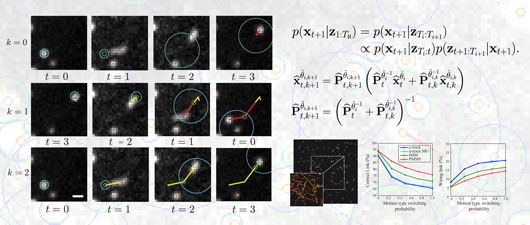The study of fast and heterogeneous displacements of intracellular particles through fluorescence microscopy is typically challenged by the limited temporal sampling caused by fluorophore photobleaching and cellular phototoxicity. In those sequences, the chemically triggered changes in molecular motions can result in the imaging of unpredictably large displacements. As such, their automatic quantification is very challenging in the typically dense intracellular context that creates ambiguities between possible trajectories. Current models for motion prediction used in multiple particle tracking are inherited from the field of aerospace engineering where each new frame is used to update the probability of the motion type for each particle. These methods fail to detect unpredictable displacements for two reasons: i) they assume a smooth transition in the motion type that is not present in bioimaging and thus cannot model instantaneous transition, ii) the large number of particles imposes very conservative limitations on the number of possible assignments that can be evaluated due to computation time.
Figure: Interrogating multiple motion types in forward and backward temporal directions (left) in an iterative stochastic smoothing framework (right) provides up to 15% increases in performances (bottom right) and opens the way for longer acquisition time and reduced photo-toxicity. (Click on image to enlarge.)
To solve this problem, we propose a piecewise-stationary motion model (PMM) for the particle transport along with an iterative smoothing step that exploits recursive tracking in multiple rounds in forward and backward temporal directions. By fusing past and future information, our method, termed PMMS, can recover fast transitions from freely or confined diffusive to directed motions that could not be predicted by conventional approaches. To ensure computational tractability, our algorithm summarizes the past and future information in the state of only two stochastic filters per particle, this information is in turn used to predict possible transitions.
Using simulated images, we found that our method pushes the boundary on the targeted problem, especially the impact of density, variation in frame to frame displacements, and motion switching probability. On experimental data, our algorithm allows us to quantify the extremely small percentage of motor-driven movements of fluorescent particles along microtubules in a dense field of unbound, diffusing particles. We also show with virus imaging that our algorithm can cope with a strong reduction in recording frame rate while keeping the same performance relative to methods relying on fast sampling.
The inter-disciplinary approach used in the HFSP Fellowship project allowed us to advance the field of multiple particle tracking in general while tackling a very specific challenge in bioimaging that would not have been identified outside a collaborative framework.
Reference
Piecewise-Stationary Motion Modeling and Iterative Smoothing to Track Heterogeneous Particle Motions in Dense Environments. P. Roudot, L. Ding, K. Jaqaman, C. Kervrann, and G. Danuser. IEEE Transactions on Image Processing PP, no. 99 (2017): 1–1. https://doi.org/10.1109/TIP.2017.2707803.



































